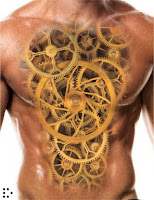Date:
Thanksgiving Day, early 1970s.
Location:
Subic Bay, Philippines.Subject: A budding tomboy, bored with waiting for turkey, heads out to her favorite tree.
Event: While doing her best impression of a ring-tailed lemur, she loses her grip and plummets to the ground.
Status: Two front teeth, missing in action.
This scenario played out when I was just a child. The teeth were never found. Luckily, my permanent incisors came in strong and healthy, but this would be the beginning of a series of dental dramas.
I was born with a very small jaw. As my permanent teeth erupted, it was clear I lacked room for a full arcade, so by the time I entered my teens, it was time to take action.
They started with my premolars, yanking four of them to provide a bit of breathing room. Then came the braces; I’m talking the clunky metal kind that were oh-so-attractive. Once the unsightly apparatus was in place, the assistant set to work carefully chipping away the excess concrete from around the bands. As the tiny flecks hit the back of my throat, they triggered my gag reflex and the next thing I knew I was hurling a partially digested egg sandwich into that tiny sink. (FYI: Those little sinks only accommodate spit.)
During my two-and-a-half-year tenure in braces, it was decided things were still too crowded, so out came my wisdom teeth. I’ve spent decades trying to convince my dentist I deserve a discount, since I lack a quarter of my inventory.
The final insult occurred on the racquetball court. I was kicking ass against two fellow firefighters when I took a racquet to the pie-hole, shattering my two front teeth. Fortunately, I had a gifted dentist who was able to reconstruct them and today, no one’s the wiser.
 Teeth
are important. If you’ve never stopped to appreciate them, take a moment.
Imagine gnawing on a juicy steak, or biting into a delicious apple. As I said,
teeth are important.
Teeth
are important. If you’ve never stopped to appreciate them, take a moment.
Imagine gnawing on a juicy steak, or biting into a delicious apple. As I said,
teeth are important.I bet you’re wondering how teeth are formed. It just so happens, I have the answer.
Tooth
development, known as odontogenesis, begins in the womb and is controlled by
over three hundred genes. By the fourth week of embryological development, the upper and
lower dental arches are formed. The arches are covered by specialized cells
that will eventually become the tooth buds; ten on top, ten on the
bottom. The buds develop a cap of enamel, forming the crown, and dentin comprises
the interior.
The
deciduous, or primary, teeth are hidden within the jaws when we are born. The
first to erupt are the two bottom incisors, usually when we’re around six
months old. The first molars erupt around our first birthday and the rest of the dentition quickly
follows. Thus, you sport a beautiful arcade of twenty tiny teeth by the time
you are three.
Then the permanents start shoving their way out.
The twenty baby teeth will eventually be replaced by thirty-two permanent teeth. Lower first molars usually take the lead, erupting around the age of six. The last to appear are the third molars, or wisdom teeth, usually in our late teens.
Permanent teeth come in four varieties: incisors, canines, premolars, and molars (front to back, respectively), and their shape is dictated by function. Incisors allow us to cut. Think back to that delicious apple… The canines are for tearing (or puncturing, if you’re a vampire). The premolars serve a dual purpose: tearing and crushing. And the molars, with their broad, bumpy surfaces, are for grinding. (Run your tongue along the chewing surfaces of your teeth and you’ll note the dramatic changes in shape)
Teeth hold information about our biological history. Dental traits are passed along as people move and mate. For example, the fascinating shovel-shaped incisors of Native Americans were one of the first clues to their Asian origins.
Our teeth are part of our evolutionary history. Over time they, along with our faces, have gotten smaller. Smaller jaws mean more crowding, thus the need for so many of us to have our wisdom teeth yanked.
But aside from the crowding, our teeth suit us to a tee. They allow us to chew, which aids digestion; they assist in speech by allowing us to form sounds; and they are key to good nutrition, for it's hard to be healthy if your teeth fall out of your head.
So now that you know how teeth erupt, stay tuned. Next week we’ll discuss some of the bizarre ways we alter and adorn our teeth as we explore the exotic custom of dental mutilation.
Tooth eruption video!

























